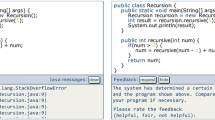Abstract
The idea of an intelligentsystem to support learning has been epitomisedby that of an intelligent tutoring system(ITS). However, ITSs are, in fact, just aparticular kind of intelligent system tosupport learning whose components reflect thevalues of the particular view that ITSsemphasise in regard to the nature of knowledge,learning and teaching, which have led to anarchitecture that focuses on representing theknowledge to be learned (domain model),inferring the learner's knowledge (learnermodel), and planning instructional steps to thelearner (teaching model). On the other hand,other views of learning may lead to differentneeds in terms of knowledge representation,reasoning, and decision making capabilities inthe intelligent systems that support them.Constructivist views, for example, emphasisedifferent values and may require an entirelydifferent architecture of intelligent system tosupport its philosophy of learning. This paperpresents an architecture of an intelligentsystem to support learning that is able toaddress the issues that arise fromconstructivist theories of learning in a waythat, rather than opposing to the standard ITSarchitecture, characterises a broader view inall its components which can be appropriatelyattuned to address the issues of particularphilosophies.
Similar content being viewed by others
References
Agre, P.E. (1995). Computational research on interaction and agency. Artificial Intelligence 72: 1–52.
Akhras, F.N. (1997). Reasoning about process in intelligent learning environments. PhD Thesis, Computer Based Learning Unit, University of Leeds, Leeds, UK.
Akhras, F.N. & Self, J.A. (2000). System intelligence in constructivist learning. International Journal of Artificial Intelligence in Education 11: 344–376.
Barwise, J. & Perry, J. (1983). Situations and Attitudes. Cambridge, MA: MIT Press.
Bednar, A.K., Cunningham, D., Duffy, T.M. & Perry, J.D. (1992). Theory into practice: how do we link? In T.M. Duffy & D.H. Jonassen, eds, Constructivism and the Technology of Instruction: a Conversation, pp. 17–34. Hillsdale, NJ: Lawrence Erlbaum.
Brown, J.S., Collins, A. & Duguid, P. (1989). Situated cognition and the culture of learning. Educational Researcher 18(1): 32–42.
Cognition and Technology Group at Vanderbilt (1990). Anchored instruction and its relation-ship to situated cognition. Educational Researcher 19(6): 2–10.
Crews, T., Biswas, G., Bransford, J., Goldman, S., Nathan, M. & Varma, S. (1995). Adven-turePlayer: macrocontext plus microworlds. In J. Greer, ed., Proceedings of the World Conference on Artificial Intelligence in Education (AI-ED'95), pp. 381–388. Washington, DC: AACE.
Davis, E. (1990). Representations of Commonsense Knowledge. San Mateo, CA: Morgan Kaufmann.
Detterman, D.K. & Sternberg, R.J., eds (1993). Transfer on Trial: Intelligence, Cognition, and Instruction. Norwood, NJ: Ablex.
Devlin, K. (1991). Logic and Information. Cambridge: Cambridge University Press.
Fosnot, C.T. (1996). Constructivism: a psychological theory of learning. In C.T. Fosnot, ed., Constructivism: Theory, Perspectives, and Practice, pp. 8–33. New York: Teachers College Press.
Gibson, J.J. (1977). The theory of affordances. In R. Shaw & J. Bransford, eds, Perceiving, Acting, and Knowing, pp. 67–82. Hillsdale, NJ: John Wiley.
Greeno, J.G. (1997). On claims that answer the wrong questions. Educational Researcher 26(1): 5–17.
Greeno, J.G., Moore, J.L. & Smith, D.R. (1993). Transfer of situated learning. In D.K. Detterman & R.J. Sternberg, eds, Transfer on Trial: Intelligence, Cognition, and Instruction, pp. 99–167. Norwood, NJ: Ablex.
Hannafin, M.J. & Land, S.M. (1997). The foundations and assumptions of technology-enhanced student-centered learning environments. Instructional Science 25: 167–202.
Honebein, P.C., Duffy, T.M. & Fishman, B.J. (1993). Constructivism and the design of learning environments: context and authentic activities for learning. In T.M. Duffy, J. Lowyck & D.H. Jonassen, eds, Designing Environments for Constructive Learning, pp. 87–108. Berlin: Springer-Verlag.
Jonassen, D.H. (1992). Evaluating constructivistic learning. In T.M. Duffy & D.H. Jonassen, eds, Constructivism and the Technology of Instruction: a Conversation, pp. 137–148. Hillsdale, NJ: Lawrence Erlbaum.
Knuth, R.A. & Cunningham, D.J. (1993). Tools for constructivism. In T.M. Duffy, J. Lowyck & D.H. Jonassen, eds, Designing Environments for Constructive Learning, pp. 163–188. Berlin: Springer-Verlag.
Lester, J.C., Stone, B.A., O'Leary, M.A. & Stevenson, R.B. (1996). Focusing problem solving in design-centered learning environments. In C. Frasson, G. Gauthier & A. Lesgold, eds, Proceedings of the Third International Conference on Intelligent Tutoring Systems (ITS'96), pp. 475–483. Montreal, Canada, Lecture Notes in Computer Science No. 1086, Berlin: Springer-Verlag.
McCarthy, J. & Hayes, P.J. (1969). Some philosophical problems from the standpoint of arti-ficial intelligence. In D. Mitchie, ed., Machine Intelligence 4, pp. 463–502. Edinburgh: Edinburgh University Press.
Mohan, P., Greer, J.E. & Jones, M.L. (1991). Adapting instruction to the cognitive needs of learners in an intelligent tutoring system. In L. Birnbaum, ed., Proceedings of the International Conference on the Learning Sciences, pp. 322–328. Evanston, Illinois: AACE.
Piaget, J. & Garcia, R. (1991). Toward a Logic of Meanings. Hillsdale, NJ: Lawrence Erlbaum.
Polson, M.C. & Richardson, J.J., eds (1988). Foundations of Intelligent Tutoring Systems. Hillsdale, NJ: Lawrence Erlbaum.
Resnick, L.B. (1987). Learning in school and out. Educational Researcher 16(9): 13–20.
Resnick, L.B. (1996). Situated rationalism: the biological and cultural foundations for learning. Prospects XXVI(1): 37–53.
Shuell, T.J. (1992). Designing instructional computing systems for meaningful learning. In M. Jones & P.H. Winne, eds, Adaptive Learning Environments, pp. 19–54. Berlin: Springer-Verlag.
Simons, P.R.J. (1993). Constructive learning: the role of the learner. In T.M. Duffy, J. Lowyck & D.H. Jonassen, eds, Designing Environments for Constructive Learning, pp. 291–313. Berlin: Springer-Verlag.
Vassileva, J. (1995). Reactive instructional planning to support interacting teaching strategies. In J. Greer, ed., Proceedings of the World Conference on Artificial Intelligence in Education (AI-ED'95), pp. 334–342. Washington, DC: AACE.
von Glasersfeld, E. (1989). Cognition, construction of knowledge, and teaching. Synthese 80: 121–140.
Winn, W. (1993). A constructivist critique of the assumptions of instructional design. In T.M. Duffy, J. Lowyck & D.H. Jonassen, eds, Designing Environments for Constructive Learning, pp. 189–212. Berlin: Springer-Verlag.
Author information
Authors and Affiliations
Rights and permissions
About this article
Cite this article
Akhras, F.N., Self, J.A. Beyond intelligent tutoring systems: Situations, interactions, processes and affordances. Instructional Science 30, 1–30 (2002). https://doi.org/10.1023/A:1013544300305
Issue Date:
DOI: https://doi.org/10.1023/A:1013544300305




